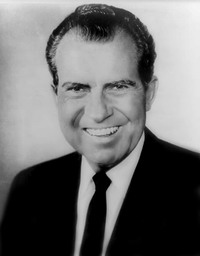Richard M. Nixon Library is now under federal control
The privately operated Richard M. Nixon Library and Birthplace experiences transition to federal control and researchers can pore over documents and tapes detailing "the good, the bad and the ugly."

After a simple opening ceremony Wednesday, library officials and docents shared champagne and cake before moving to the research room to view 78,000 newly released Nixon papers and 11½ hours of audio tape.
"This is a great day for history. The hallmark of this new institution will be true acceptance and love for history - the good, the bad and the ugly," said Timothy Naftali, the museum's new federal director. "We are moving past the tribal squabble."
For nearly 20 years, library visitors were told the Watergate scandal was really a "coup" by Nixon's rivals and the investigative reporting team of Bob Woodward and Carl Bernstein offered bribes for their scoops that eventually led to Nixon's downfall.
The new library director is taking some of the whitewash off the scandal resulting from the break-in at Democratic headquarters in the Watergate complex in Washington and the subsequent White House cover-up. The revised account is a precondition for receiving 42 million pages of the former president's papers and nearly 4,000 hours of tapes from the National Archives.
Transition to federal control ushers the black sheep of presidential libraries into the fold of the prestigious National Archives.
The new papers offer insight into the 37th U.S. president's role as a Republican Party strategist and party leader and join Nixon's pre- and post-presidential papers, which were already in California. They were a gift from the Nixon Foundation and are not usually part of a presidential collection, said Susan Cooper, a spokeswoman for the National Archives.
The documents show a keen interest, if not preoccupation, with stage-managing Nixon's appearances and include advice that he pay more attention to his wife, Pat, when the two are in public.
"From time to time he should talk to her and smile at her," TV adviser Roger Ailes told Nixon's chief of staff, H. R. Haldeman, in a May 1970 memo, after noting that the president walked away from her at a Houston event and she had to run to catch up. "Women voters are particularly sensitive to how a man treats his wife in public."
Ailes also urged Nixon to wear "make-up or at least beardstick" in outdoor appearances. "A double layer of beardstick should be applied to the area above the upper lip," he wrote.
Haldeman apparently was not sold on that: A note scribbled on the margin says: "I disagree if he's going thru the crowd."
The Nixon White House also paid close attention to perceived friends and enemies in the media, ranking TV newsmen or anchors Roger Mudd, Eric Sevareid, John Chancellor and David Brinkley as the most powerful journalists on television who were "clearly against us."
CBS anchor Walter Cronkite was judged neutral "except on Indochina," and Barbara Walters was approvingly described as having "a large national following, but doesn't assert views." The memo ranking commentators and columnists was undated and unsigned.
A March 1970 memo for Nixon reported on attempts to patch up relations with Ronald Reagan, then California governor. Among Reagan's beefs was that Nixon would not return his calls.
Harry S. Dent, a political affairs aide for Nixon, spent 90 minutes with the governor trying to smooth things over. "The Governor has been concerned about not being able to get the President on the telephone when he calls," Dent wrote. "Fortunately, he called last week on a 'test call' and the President returned the call promptly."
With the stamp of the federal system for library comes a major makeover for certain less-than-accurate exhibits - a relief to Nixon scholars who were frustrated by the way the private institution had portrayed the Watergate scandal and Nixon's foreign policy.
Naftali recently oversaw the demolition of the revisionist Watergate gallery, including a section that said the scandal was a coup plotted by Democrats. The museum also told visitors that the infamous 18½ minute gap in one important White House tape - a conversation three days after the break-in - was because of a mechanical malfunction.
"No serious historian believes in that," said David Greenberg, a Nixon scholar and professor at Rutgers University. "It's not only not true, it's the opposite of truth. There was a lot along those lines in the library, which was not a matter of interpretation, but was flat wrong, a lie."
In its place, Naftali promises an updated display featuring oral accounts from key players in the Watergate saga, a selection of White House tapes, clips from broadcast news and footage of the Watergate hearings.
Subscribe to Pravda.Ru Telegram channel, Facebook, RSS!




